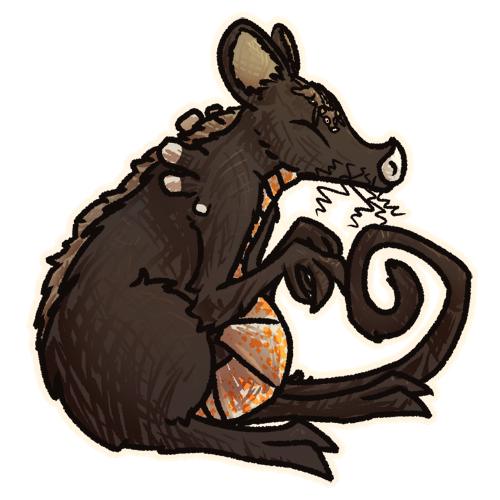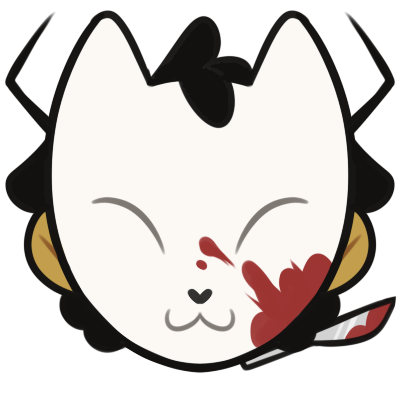[Cosmosdex] The Universal Encyclopedia
[Cosmosdex]
Ivfrid
Pick of the Litter
Ivfrid

Art by, Chipper
- Strength-1
- Intelligence-1
- Charisma-1
- Endurance-2
- Agility-4
- Luck-7
Danger Level: Low
Likes: Food, Attention, A Safe Nest
Dislikes: Being In An Open Space
Attack Method: Leaps onto target and digs it's teeth into the hide while crawling across the body. Or scratching.
Attributes
Environment: Eukaryote, Forests, Jungles, Mountains, as PetsLifespan: 4 Months
Size: 0.6 ft tall, 1 ft long
Diet: Mutualism, Plants, Any(non-adults)
Bodytype: Quadruped
Type: Mammal
Rarity: Extremely Common
Original Creator: Voidtraipser
Physical Description
Ivfrids are often described as docile pillows. These neutral-toned psuedo-synapsids are coated with a downy coating of fibers on most of their body. Their underbelly is a narrow diamond of scale-like plates with very bright speckles ranging from turqoise to orange. Most have large whiskers, dish-like ears, and a crest running down their body. The crest starts from the forehead and runs to the wiry tail, being lighter or darker than their body's fur. Each ivfrid has a head, four legs, and a tail. The front legs are zygodactyl and the back are didactyl.
In addition to the front legs being used for grasping, ivfrid has chains of muscular nubs that run from shoulder to shoulder allowing it to safely bounce and tumble if it falls from a height, but also letting it keep a grip on prey and predators alike. The same nubs also allow the ivfrid to filterfeed by their breathing motions, as each one supplies airflow to bacterial colonies living in small glands connected to these bumps on the body. The same colonies drain sugary waste fluid into the ivfrid's digestive system, and reduces it's need to forage as a form of mutualism.
Due to this process their teeth can grow sharper and longer than they would without this. As they age they go from being more of a narrow ovoid to a near orb-like shape. Most owners describe them as becoming more 'fluffed' or 'cushioned' as they age, and is a reason they are often used as a pillow when the owner goes to sleep. That, and because their fibers and metabolic processes cause them to be cold when it is warm, and warm when it is cold.
The reason for all of these traits is that the ivfrid is born pregnant, and in the wild will die giving birth to it's litter at four months of age. All litters born will, rather than being clones, be offspring of their parent by way of genetic cascade. A third of each litter will be runts, most will be just as well adapted to survival as their parent, and usually there will be one that is an improvement above the rest in some form.
Behavior
As a capture creature bred for usage as a notail starter, the ivfrid is both very docile, affectionately so, tolerant of high levels of pain, and bred for a unique purpose. The ivfrid is notable because from before birth all members of the species are pregnant. Ivfrids are much more comfortable lazily grazing and resting than actively foraging, but don't mind being on the move if they're carried. Freshly born ivfrids will begin to cannibalize their parent, and often the runts of the litter will follow after.
Near the end of the lifespan the ivfrid will experience heightened anxiety and lethargy as it becomes more concerned with both keeping safe, but also because it's pregnancy bloats the body as it continues. In captivity this is less of an issue as the ivfrid is given proper care, and is able to carry another litter afterwards. Any ivfrid that survives delivery will clean their young, and then nurse them via their nub-glands. The young will wean within a few days, and will stick close to the parent as they do in the wild, unless a threat appears, at which point they scatter for safety.
Their ability to burrow is reduced at young age, but they can still find a nook to squeeze into for safety. Luckily breeders don't give newborns hiding spots to run to. Due to how well they breed they are generally available from most breeders, but due to their mortality rate when birthing in the woods they are recommended as starters for B, M, S, V, and Z-classes. Those slow to pick up their starter, or those who are a G or Q-class will be given a runt of some variety. Runts are known to experience a mix of conditions ranging from very slow reflexes, severe anxiety, inability to feed from their colonies, infections from their glands, sluggish mobility, little to no grip strength, and temperature regulation issues.
If one is even less lucky they'll be given an ivfrid who is either on their last litter, or is unable to create further ones. These specimens will deliver low quality litters, or will have the issues that old age brings in most capture creatures. For these their best hope is to be used as bait to catch a better capture creature, or to be butchered painlessly for rations. The goal for each owner is different.
B-classes use this starter to learn to determine quickly which is the best adapted out of a group for survival, and to prevent attachment to subjects. M-classes typically are to keep the breeder alive long enough for delivery, and each successive litter will reduce the attachment they will feel when they are caring for young notails. S-classes use this starter to ensure they can operate with speed, efficiency, and a struggling patient, as young ivfrids will be moving about inside their parent by delivery. V-classes are supposed to do about the exact same, but to raise a couple from each litter to be used as bait to get better team members. Z-classes have the same endgoal as V-classes with this starter, to raise them for usage as bait.
In the event that a child is given a dud, or has to deal with a sub-optimal litter result, the guide for picking a starter reminds prospective owners that they'll only have to wait another four months to get an improvement, and that if they can keep two of a litter alive, the weaker one can be traded for the same reason. Some owners use this, and light repeated doses of mutagen over multiple successive litters, as a means to get a decent teammate.
Subspecies
Wild: This variety of ivfrid can deliver safely and survive it. They sport a lifespan of 4 years on average. Their nubs barely provide anymore nutrition than supplemental, and lack proper grip. Their teeth also rarely get as long due to being omnivorous, they lack the same insulating properties, and are more susceptible to mutations. Due to the last property V and Z classes will bring wild specimens back for the purpose of playing with their genes until something worth adding to the main variety is found, but this is a rare event nowadays.
Breeder: This variety delivers after a month although litters are much more rare to produce stronger heirs, and are typically only available to M and T classes. This saddles them with the challenge of keeping as many of a litter alive to bear young, and using that to trade with others in the woods. Proper labs and stores will give the parent treatments so that offspring delivered are of whatever variety needed.
Cessarean: This subspecies needs surgical intervention to deliver. In addition their scaled underbelly is weaker where it meets the furred flesh. This makes for a more clean incision point, but also reattaches easier in the event that the prospective parent survives the process. Often reserved for S and V classes, they will need to operate on the parent quickly enough to get the litter proper exposure to air, and avoid damaging or killing the squirming, pink newborns. If they fail, they will have to either get a replacement, or deal with a less than desired heir.
Special
Generational Improvements: Litters inherit the power of their parent unless they are a runt which has penalties all around to their power, or an heir which tends to be a tad more powerful than the parent. Ivfrids are able to produce a single offspring that is much better adapted than their parent each generation, and anyone who invests the proper time can obtain a perfect ivfrid. This process can take several years.
Trivia
• One of the most frequent usages of this capture creature is as fodder for a recent fad in the capture creature community, wherein people submit one for trade and receive a randomly selected creature that is in the same tradepool. Some have argued that people who flood these trades with ivfrids should be banned from the service, while others make more violent requests.
• It isn't uncommon in the community to see an capture creature trainer who proclaims loudly for anyone interested that their ivfrids are the ultimate in ivfrids
• The evolved form of ivfrid is rarely seen despite it being an improvement in nearly every way. Most owners state that it's uglier, and that the time it takes to create a single perfect ivfrid isn't worth the risk of trying to evolve it. Those who manage to evolve a perfected ivfrid into it's evolved form will however own a capture creature with power rivaling traditionally stronger capture creatures, though.
Image Gallery
No art currently, maybe you can help.


